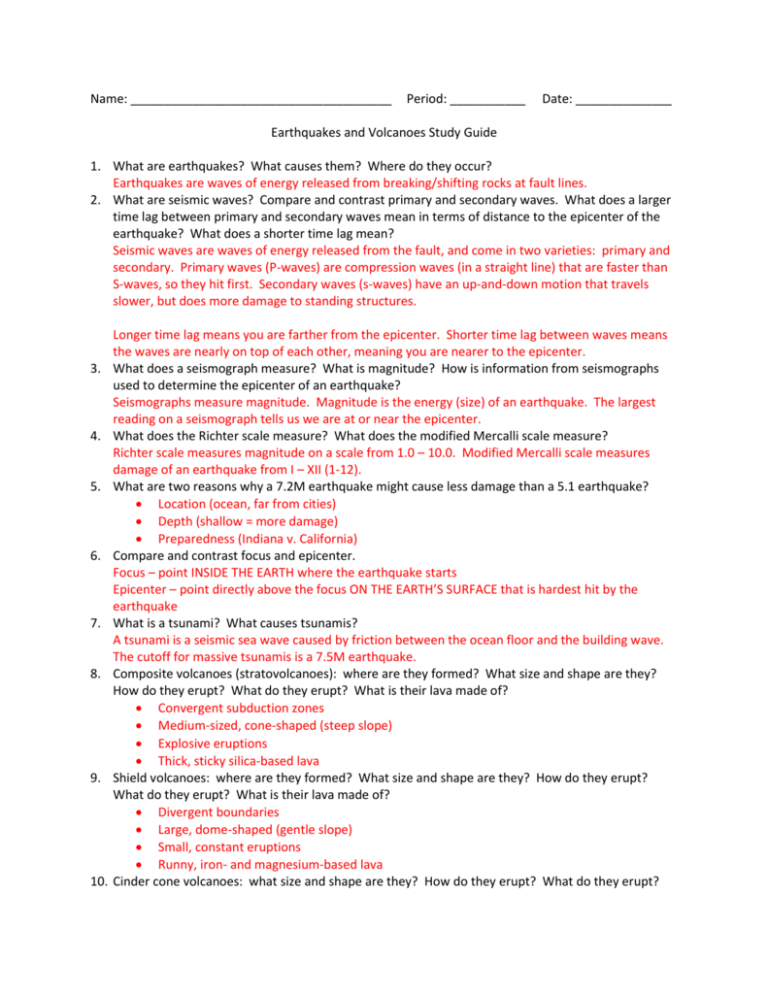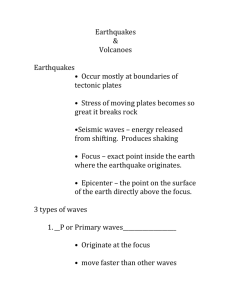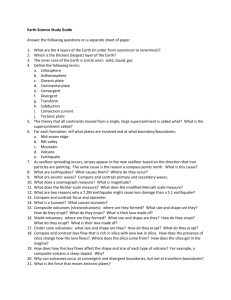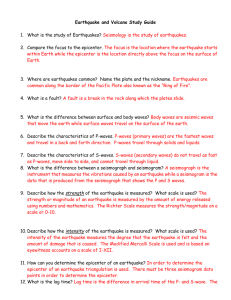Name: Period: ______ Date: Earthquakes and Volcanoes Study
advertisement

Name: ______________________________________ Period: ___________ Date: ______________ Earthquakes and Volcanoes Study Guide 1. What are earthquakes? What causes them? Where do they occur? Earthquakes are waves of energy released from breaking/shifting rocks at fault lines. 2. What are seismic waves? Compare and contrast primary and secondary waves. What does a larger time lag between primary and secondary waves mean in terms of distance to the epicenter of the earthquake? What does a shorter time lag mean? Seismic waves are waves of energy released from the fault, and come in two varieties: primary and secondary. Primary waves (P-waves) are compression waves (in a straight line) that are faster than S-waves, so they hit first. Secondary waves (s-waves) have an up-and-down motion that travels slower, but does more damage to standing structures. 3. 4. 5. 6. 7. 8. 9. 10. Longer time lag means you are farther from the epicenter. Shorter time lag between waves means the waves are nearly on top of each other, meaning you are nearer to the epicenter. What does a seismograph measure? What is magnitude? How is information from seismographs used to determine the epicenter of an earthquake? Seismographs measure magnitude. Magnitude is the energy (size) of an earthquake. The largest reading on a seismograph tells us we are at or near the epicenter. What does the Richter scale measure? What does the modified Mercalli scale measure? Richter scale measures magnitude on a scale from 1.0 – 10.0. Modified Mercalli scale measures damage of an earthquake from I – XII (1-12). What are two reasons why a 7.2M earthquake might cause less damage than a 5.1 earthquake? Location (ocean, far from cities) Depth (shallow = more damage) Preparedness (Indiana v. California) Compare and contrast focus and epicenter. Focus – point INSIDE THE EARTH where the earthquake starts Epicenter – point directly above the focus ON THE EARTH’S SURFACE that is hardest hit by the earthquake What is a tsunami? What causes tsunamis? A tsunami is a seismic sea wave caused by friction between the ocean floor and the building wave. The cutoff for massive tsunamis is a 7.5M earthquake. Composite volcanoes (stratovolcanoes): where are they formed? What size and shape are they? How do they erupt? What do they erupt? What is their lava made of? Convergent subduction zones Medium-sized, cone-shaped (steep slope) Explosive eruptions Thick, sticky silica-based lava Shield volcanoes: where are they formed? What size and shape are they? How do they erupt? What do they erupt? What is their lava made of? Divergent boundaries Large, dome-shaped (gentle slope) Small, constant eruptions Runny, iron- and magnesium-based lava Cinder cone volcanoes: what size and shape are they? How do they erupt? What do they erupt? Small, cone-shaped Explosive bursts of hot gases, ash, and cinders 11. Compare and contrast lava flow that is rich in silica with lava low in silica. How does the presence of silica change how the lava flows? Where does the silica come from? How does the silica get in the magma? Rich in silica – slow, thick flow that doesn’t travel far before cooling Low in silica – thin, runny flow that spreads out and cools in thin layers 12. 13. 14. 15. 16. Silica comes from the melting of tectonic plates (convergent subduction zones). How does how the lava flows affect the shape and size of each type of volcano? For example, a composite volcano is steep sloped. Why? See above – thick lava builds up, not out, forming a short cone. Runny lava, like water, flows long distances, spreading a thin layer over the foundation and forming a tall, wide mountain. Why can volcanoes occur at convergent and divergent boundaries, but not at transform boundaries? Convergent and divergent boundaries allow for magma to seep up to the crust. Transform boundaries do not melt crust or open up to the mantle, so there is no “fuel” for volcanoes. What is the force that moves tectonic plates? Convection currents Lava from volcanoes moves slowly enough for people to get away from it. What are three reasons why volcanic eruptions are still dangerous? Mudslides, avalanches, pyroclastic flow, flooding, falling tephra, heat, poisonous gases, ash, flying debris, etc. When does a volcano become extinct, which means that it will never erupt again? Volcanoes become extinct after they lose their magma source (eg, Hawaii – islands move off the hot spot). We judge volcanoes “extinct” after 10,000 years of no eruptions, but these judgments are not always correct.






